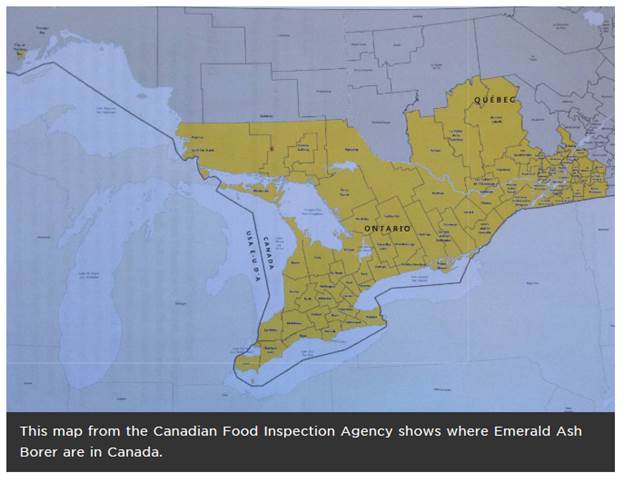
Destructive, invasive beetle heading for the Maritimes
GlobalNews.ca
July 5, 2017
Natasha Pace
Forestry experts are preparing for a new and invasive species to hit our region.
The Emerald Ash Borer (EAB) is a non-native insect pest from Asia. It was first introduced in Canada and the United States in 2002 and now the beetle is making its way to Nova Scotia.
“It’s coming. There’s no stopping it,” said Andrew Williams, the urban forestry coordinator for the Town of Truro.
“It’s now east of Montreal and basically only a days drive away from Atlantic Canada and there’s a lot of concern about the potential damage it’s going to have both in our urban forest to our ash tree population and as well our working forest.”
The Emerald Ash Borer is about a half inch long and a half inch wide.
The back of the beetle is a metallic green colour, while the underside is a bright emerald green. It’s body is narrow and elongated and the head is flat.
Experts say the adult insects are not the problem, it’s the larvae.
About ten days after eggs are laid, larvae emerge and feed beneath the bark of ash trees – cutting off their ability to move water and nutrients.
Once an ash tree is infected, they are lost within one to three years.
“It has the ability to eliminate ash from North America. There’s no, at this point, no natural predators or diseases or checks and balances to keep populations in check,” Williams said.
Monitoring traps have been placed in some ash trees in areas across Nova Scotia, like Truro.
The trap is coated on the outside with a sticky substance and on the inside there’s a pheromone to help attract the insects.
Officials from the Town of Truro and the Canadian Food Inspection Agency will be checking the traps, looking for any sign of an infestation.
Experts say once Emerald Ash Borer beetles arrive, they are going to have a significant environmental impact and could cost Nova Scotia millions of dollars.
“Typically, in an urban forestry setting it’s the municipalities that are left to deal with the problems. The lowest level of government with the least financial resources will be cleaning it up,” Williams said.
“Environmentally, it has the potential to have a huge impact. If we lose large packs of our ash species in North America, it will have a dramatic impact on our forest lands as well as everything from water to climate change to everything that goes along with large tree loss.”
Since it’s arrival in Canada, the Emerald Ash Borer has killed tens of millions of ash trees.

It’s believed the Emerald Ash Borer was introduced accidentally into North America through imported wood packaging or crating material.
Scientists with The Canadian Forest Service (CFS) estimate the cost to treat, remove and replace trees affected by the beetle could reach $2 billion over a 30 year period.
“The Emerald Ash Borer is a highly destructive pest. It has killed millions of trees in Ontario and Quebec and the places it has been introduced in the United States, so it’s certainly a pest that we’re very concerned with,” said Ronald Neville, a plant health survey biologist with the Canadian Food Inspection Agency (CFIA).
At this time, there is no indication exactly when the Emerald Ash Borer will arrive in Nova Scotia.
However, officials are asking for help from the public to protect trees from invasive insects and diseases.
The CFIA is encouraging people not to transport firewood. They say moving firewood from places where invasive insects have been found can be in violation of the Plant Protection Act and can come with stiff penalties, including fines up to $50,000.
Officials say instead of moving firewood, buy and burn it locally.
